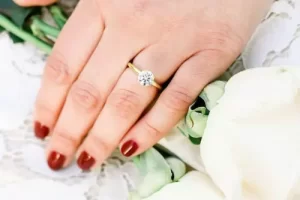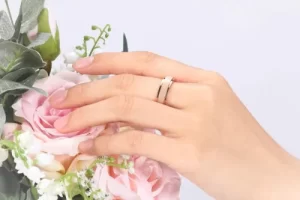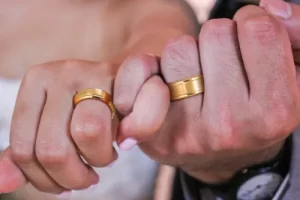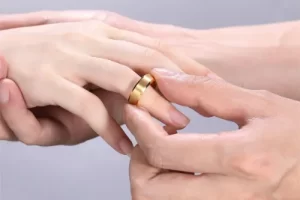Wedding bells are a beautiful occasion and we want to make it as memorable as possible. The wedding ring is a very important part of the occasion and we take immense care while buying it, ensuring it is also a symbol of love that’s shared and one that the partner likes. Besides the matters of the heart, we also have to confirm if that’s the right size and fits their finger.
So, it’s also important to know which finger and which hand the wedding ring goes on. There are engagement rings, eternity rings and wedding rings, and each of these varies based on the places, cultures and traditions. The placement of the ring also varies across the globe. So, if you want to know what hand the wedding ring goes on, here is a detailed explanation of the ring, its placement in different cultures and the history behind the practices and beliefs.

What Hand Does a Wedding Ring Go on?
For instance, in cultures like ancient Egypt, the wedding ring should be worn on your left hand. This is a common habit in Western cultures even today. But in a few other cultures, the tradition is to wear a wedding ring on their right hand.
Left hand – The culture in most countries in Europe is to wear the wedding ring on the fourth finger of the left hand. The fourth finger is also commonly known as the ring finger.
So, in such cultures, even the engagement finger goes on the left hand. Sometime before the wedding ceremony, the engagement ring is exchanged on the right hand.
Right hand – In several other countries like Russia, India, Latvia, Bulgaria, Ukraine, Spain, Norway, Austria and others, the rings are placed on their right hand.
In a few countries like Germany and the Netherlands, the engagement ring goes on the left hand, while the wedding ring is worn on the right hand.

History of a Wedding Ring
A wedding ring is not relatively a new concept. It’s been practiced for centuries together across different cultures and places. For instance, archaeological findings suggest that a wedding ring crafted using reeds, leather and bone was used by the ancient Egyptians and was found on their left hand. The period we are talking about is 4000 BC. Such a culture is also found in ancient Greece and Rome periods as well.
What is the Meaning?
There are reasons and meanings associated with why different cultures prefer either the right hand or left hand for the placement of a wedding ring. Likewise, historically, not all cultures had the practice of wearing the ring only on the fourth finger. But it slowly became a concept that many people in the world across ages and cultures have begun to believe in. The ring is often worn on the fourth finger, aka ring finger, because it is believed across the world that this finger has a special connection to the heart. It is said that a vein connects that finger and the heart, therefore the ring on the fourth finger has a special meaning. The ancient people also referred to it as vena amoris (vein of love) for the same reason.
Left hand – When people talk about the concept of the fourth finger being connected to the heart, they usually refer to the fourth finger in the left hand. It is basically why in several countries, people prefer to wear the wedding ring in the left hand.

Counties that prefer/follow the left-hand wedding ring rule – Most Western countries including North and South America, United Kingdom, France, and Italy. It is also followed in China.
Right hand – Ancient Romans are known for kickstarting the culture of wearing the wedding ring on the right hand. But it doesn’t have a very positive reason. In most cultures, even today, the left hand isn’t believed to be a lucky or happy one. It is why even people who are basically left-handed are made to use their right hand to write. It is one of the said reasons why Romans preferred wearing their ring on the right hand. All said, several people do not hold on to such thoughts now and today, it is only a customary tradition that’s been followed for several ages.
A few left-handed people find it comfortable and preferable to wear the wedding ring on their right hand as people mostly prefer to wear the ring on the less dominant hand. Members of the LGBTQIA+ community often believe wearing the wedding ring on the right hand represents a monogamous and loyal relationship.
Counties that prefer/follow the right-hand wedding ring rule – Latvia, Hungary, Greece, Serbia, Russia, Belgium, Portugal, Ukraine, Bulgaria, Austria, Poland, Spain, Denmark, Cuba, Norway, Peru, Colombia, Jordan, and Venezuela.

Other Cultures
No one rule applies across the world. In different cultures, the practices and habits are different. Besides, in the modern world, there is flexibility to wear rings on whichever hand we prefer. There are also cultures where the practice is quite different. For example, in Syria, Brazil and a few other countries, the couple wear the ring on their right hand pre-ceremony and move it to their left hand after they get married. Similarly, in Sri Lanka, the bride wears the wedding band on their left hand, while the groom wears it on their right.

Other Rings
A promise ring is worn before a proposal or marriage and most people in North America, where such a culture is also prominent, wear their promise ring on their left hand. In European countries, a promise ring often goes on the right hand. The engagement ring is often worn on the left hand until the wedding happens.
Conclusion
Wearing a wedding ring is any day a personal and memorable choice. So even if there are many customs and practices followed in different cultures, in this modern world, it all depends on what the couple prefers. At the end of the day, all we want is a magical experience.

